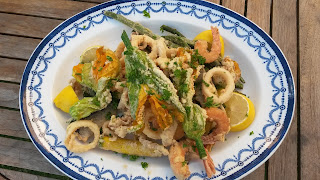August is a month when a great variety of fruit and veg is in season. In the lingering days of summer, tomatoes and stone fruit ripen, and beans and courgettes provide a great bounty of produce. As the month draws to its conclusion, we often get the first signs of autumn: cool dewy mornings and darker evenings. This is reflected in the produce available, with the first of the wild mushrooms, blackberries, cobnuts and the earliest apple varieties. The Glorious Twelfth, when the grouse season begins, heralds the start of the game season.
 |
| August days on the South Downs |
In the veg plot
Along with July, August is the month when the vegetable grower reaps his or her biggest rewards.
Courgettes, runner beans, french beans and
tomatoes are all in season - often in huge abundance. At the moment my veg plot is an embarrassment of riches, and dinner involves a daily challenge of finding new and novel ways to eat courgettes and runner beans. Courgettes are great when picked small, when they can be either deep-fried in a light batter as part of a fritto misto, or eaten raw in a salad.
Courgette flowers are also very tasty, and hard to buy in the shops. Again, they are great in a fritto misto, in salads and pasta sauces.
 |
| Courgettes and their flowers in a fritto misto |
August is also a good time for summer root veg, such as beetroot and carrots. Beetroots can be grown in a great array of colours other than the classic dark red, such as yellow and the white and red striped chioggia. I have just started harvesting
kohlrabi from the garden. Eaten raw, it has a wonderful fresh apple flavour, and an almost artichoke-like flavour when cooked. Lots of salad leaves are in season in August, though I find that many do have a tendency to want to go to flower. Swiss chard and spinach are also in season, as are British sweetcorn.
 |
| kohlrabi |
Preserving is a good way of dealing with gluts. I love making
chutneys and piccalilli. Firmer garden vegetables such as beetroot and
beans are also good pickled or preserved under oil.
In August, many herbs such as oregano and marjoram go to flower. It is worth pruning them back, and drying the prunings to use over the winter. If you do this in the first half of August, the plants should have enough time to grow back for the autumn.
Fruit
By August, most soft fruit is past its best. The two exceptions are raspberries and blackberries, which fruit well into autumn. August is the prime month for British stone fruit, like plums and greengages. Plum trees usually fruit more or less at the same time. A glut of plums can be preserved as jam,
plum chutney or plum ketchup. By the end of the month, as the seasons start to change, the very earliest varieties of English apple, such as Worcester Pearmain, become available.
From the hedgerows
August is a good month for foraging. The first blackberries can be picked in August - usually those on bushes in sunny sites. Blackberries are great in
crumbles, jams and summer puddings. Elderberries also ripen in August. Traditionally used to make wine, they can be used in cooked desserts and cordials. Be warned, they are quite pippy. Kentish cobnuts also make their appearance in August. These green nuts, closely related to hazels, are lovely eaten on their own, and can be used in salads and terrines.
Mushrooms
August is a good time to start looking for
mushrooms. Out walking this weekend, on the first of the month, we found a good haul of field mushrooms. Giant puffballs and parasol mushrooms also start to appear in grassland in August. In woodland, ceps and chanterelles can often be found, particularly after a damp spell or once the nights start to get a bit cooler.
The glories of the Twelfth
The twelfth of August, the 'Glorious Twelfth', heralds the start of the game season, as the grouse season opens. The Twelfth is heralded with much excitement, and many restaurants and butchers fall over themselves to have grouse on their menus or in their windows on the evening of the twelfth or the thirteenth. These early birds are usually hugely expensive. I usually wait until the end of the month before buying grouse, by which time the price has usually reduced significantly. Grouse usually benefit from at least a few days' hanging to relax the meat and improve the flavour, another reason to wait a few weeks before indulging.




No comments:
Post a Comment